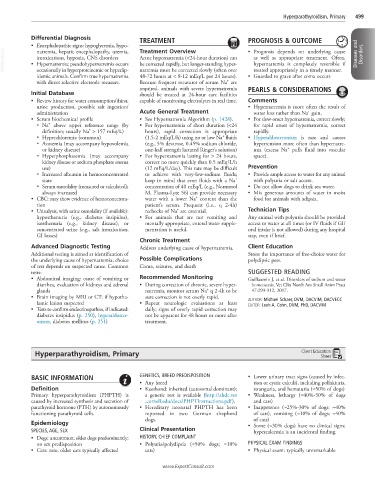Page 1015 - Cote clinical veterinary advisor dogs and cats 4th
P. 1015
Hyperparathyroidism, Primary 499
Differential Diagnosis TREATMENT PROGNOSIS & OUTCOME
• Encephalopathic signs: hypoglycemia, hypo- Treatment Overview • Prognosis depends on underlying cause
VetBooks.ir • Hypernatremia: pseudohypernatremia occurs Acute hypernatremia (<24-hour duration) can as well as appropriate treatment. Often, Diseases and Disorders
natremia, hepatic encephalopathy, uremia,
intoxications, hypoxia, CNS disorders
hypernatremia is completely reversible if
be corrected rapidly, but longer-standing hyper-
treated appropriately in a timely manner.
occasionally in hyperproteinemic or hyperlip-
48-72 hours at < 8-12 mEq/L per 24 hours).
idemic animals. Confirm true hypernatremia natremia must be corrected slowly (often over • Guarded to grave after coma occurs
+
with direct selective electrode measure. Because frequent measures of serum Na are
required, animals with severe hypernatremia PEARLS & CONSIDERATIONS
Initial Database should be treated at 24-hour care facilities
• Review history for water consumption/thirst, capable of monitoring electrolytes in real time. Comments
urine production, possible salt ingestion/ • Hypernatremia is more often the result of
+
administration Acute General Treatment water loss rather than Na gain.
• Serum biochemical profile • See Hypernatremia Algorithm (p. 1428). • For slow-onset hypernatremia, correct slowly;
+
○ Na above upper reference range (by • For hypernatremia of short duration (<24 for rapid onset of hypernatremia, correct
+
definition; usually Na > 157 mEq/L) hours), rapid correction is appropriate rapidly.
+
○ Hyperchloremia (common) (1.5-2 mEq/L/h) using no or low Na fluids • Hyperaldosteronism is rare and causes
○ Azotemia (may accompany hypovolemia (e.g., 5% dextrose, 0.45% sodium chloride, hypertension more often than hypernatre-
+
or kidney disease) one-half strength lactated Ringer’s solution) mia (excess Na pulls fluid into vascular
○ Hyperphosphatemia (may accompany • For hypernatremia lasting for > 24 hours, space).
kidney disease or sodium phosphate enema correct no more quickly than 0.5 mEq/L/h
use) (12 mEq/L/day). This rate may be difficult Prevention
○ Increased albumin in hemoconcentrated to achieve with very-low-sodium fluids; • Provide ample access to water for any animal
+
state keep in mind that even fluids with a Na with polyuria or salt access.
○ Serum osmolality (measured or calculated); concentration of 40 mEq/L (e.g., Normosol • Do not allow dogs to drink sea water.
always increased M, Plasma-Lyte 56) can provide necessary • Mix generous amounts of water in moist
+
• CBC: may show evidence of hemoconcentra- water with a lower Na content than the food for animals with adipsia.
tion patient’s serum. Frequent (i.e., q 2-4h)
+
• Urinalysis, with urine osmolality (if available): rechecks of Na are essential. Technician Tips
hyposthenuria (e.g., diabetes insipidus), • For animals that are not vomiting and Any animal with polyuria should be provided
isosthenuria (e.g., kidney disease), or mentally appropriate, enteral water supple- access to water at all times (or IV fluids if GI/
concentrated urine (e.g., salt intoxication, mentation is useful. oral intake is not allowed) during any hospital
GI losses) stay, even if brief.
Chronic Treatment
Advanced Diagnostic Testing Address underlying cause of hypernatremia. Client Education
Additional testing is aimed at identification of Stress the importance of free-choice water for
the underlying cause of hypernatremia; choice Possible Complications polydipsic pets.
of test depends on suspected cause. Common Coma, seizures, and death
tests: SUGGESTED READING
• Abdominal imaging: cause of vomiting or Recommended Monitoring Guillaumin J, et al. Disorders of sodium and water
diarrhea, evaluation of kidneys and adrenal • During correction of chronic, severe hyper- homeostasis. Vet Clin North Am Small Anim Pract
+
glands natremia, monitor serum Na q 2-4h to be 47:293-312, 2017.
• Brain imaging by MRI or CT: if hypotha- sure correction is not overly rapid. AUTHOR: Michael Schaer, DVM, DACVIM, DACVECC
lamic lesion suspected • Repeat neurologic evaluations at least EDITOR: Leah A. Cohn, DVM, PhD, DACVIM
• Tests to confirm endocrinopathies, if indicated: daily; signs of overly rapid correction may
diabetes insipidus (p. 250), hyperaldoster- not be apparent for 48 hours or more after
onism, diabetes mellitus (p. 251) treatment.
Hyperparathyroidism, Primary Client Education
Sheet
BASIC INFORMATION GENETICS, BREED PREDISPOSITION • Lower urinary tract signs (caused by infec-
• Any breed tion or cystic calculi), including pollakiuria,
Definition • Keeshond: inherited (autosomal dominant); stranguria, and hematuria (≈50% of dogs)
Primary hyperparathyroidism (PHPTH) is a genetic test is available (http://ahdc.vet • Weakness, lethargy (≈40%-50% of dogs
caused by increased synthesis and secretion of .cornell.edu/docs/PHPTInstructions.pdf). and cats)
parathyroid hormone (PTH) by autonomously • Hereditary neonatal PHPTH has been • Inappetence (≈25%-30% of dogs; ≈40%
functioning parathyroid cells. reported in two German shepherd of cats), vomiting (≈10% of dogs; ≈40%
dogs. of cats)
Epidemiology • Some (≈30% dogs) have no clinical signs;
SPECIES, AGE, SEX Clinical Presentation hypercalcemia is an incidental finding.
• Dogs: uncommon; older dogs predominantly; HISTORY, CHIEF COMPLAINT
no sex predisposition • Polyuria/polydipsia (≈50% dogs; ≈10% PHYSICAL EXAM FINDINGS
• Cats: rare; older cats typically affected cats) • Physical exam: typically unremarkable
www.ExpertConsult.com

